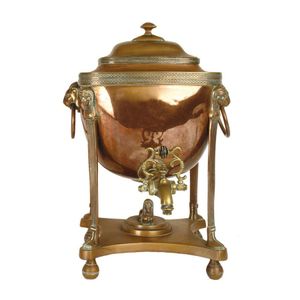Regency Copper and Brass Samovar with Egyptian Motifs
You must be a subscriber, and be logged in to view price and dealer details.
Subscribe Now to view actual auction price for this item
When you subscribe, you have the option of setting the currency in which to display prices to $Au, $US, $NZ or Stg.
- Caryatid - A Greek term that in architecture applies to a carved or cast female figures that acts as a column or pillar, supporting an entablature on her head.
In decorative arts , in furniture of the Renaissance and Classical Revival periods. Male figures are known as Atlantes.
Carved figures are rare on Australian furniture until the later 19th century, Australian craftsmen generally preferring to adopt the designs of the pattern books to rather more simple forms, such as scrolls or columns. - Lion Mask - The lion mask has been used for centuries in various forms of art and design, including furniture, silver, and ceramics, and is usually y depicted as a stylized representation of the face of a lion, often with an open mouth and protruding tongue. and is often used as a handle, knob, or other decorative element.
In furniture design, lion masks were popular in the neoclassical and Empire styles of the late 18th and early 19th centuries. They were often used as decorative elements on the legs or arms of chairs, as well as on cabinet and drawer pulls. It was also used as a handle, knob, or other decorative element.
In silverware design, lion masks were often applied to tea and coffee pots, as well as on candlesticks, snuff boxes, and other small silver items. The lion mask was often used in combination with other neoclassical motifs, such as laurel wreaths or acanthus leaves, to create a sense of grandeur and classical elegance.
In ceramics, lion masks were often depicted in relief, and were sometimes used in combination with other decorative elements, such as garlands or swags. - Tier - One or more under-shelves of a table or cabinet.
- Regency Period - The Regency period in English furniture design refers to the period when King George III, was declared unfit to rule in 1811, and his son ruled as proxy as Prince Regent, until 1820, and then, after the death of his father as George IV until his death in 1830. The Regency period was preceded by the Georgian period (George I, George II, and George III: 1714 - 1811), and was followed by the William IV period, which only lasted until 1837 when William IV died as was succeeded by Queen Victoria.
This item has been included into following indexes:
Visually similar items

A bronze Ding style censer, 19th century decorated with lotus and zoomorphic face pattern, coupled with zoomorphic legs, 18 cm high with stand. Provenance: A private collection in Japan

A Victorian mahogany shield back hall chair, the back with a combination of overlaid shields with furled carvings, plain seat raised on tapering turned legs

Victorian 3 tier what not with fretwork panel at the back of each shelf and a drawer below the bottom shelf, 92 cm wide, 123 cm high

European bombe shaped side cabinet painted panel, bronze mounts, approx 121 cm high, 74 cm wide, 42 cm deep
